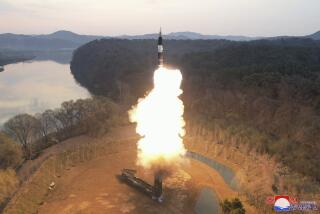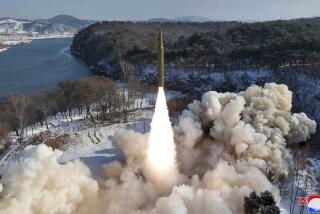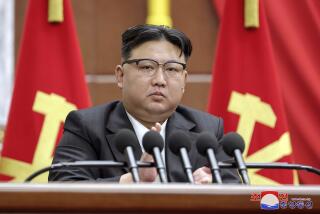Trump officials chafe at second-guessing of North Korean missile sites

When workers at North Korea’s Sohae rocket facility began rebuilding the dormant site’s launchpad and engine test stand this month, U.S. spy satellites orbiting overhead quickly detected the construction.
So did Joe Bermudez, a freelance North Korea military expert who keeps close tabs on unclassified overhead photos of the country’s scattered missile and nuclear weapons facilities.
Unlike U.S. intelligence agencies, Bermudez immediately went public.
“North Korea is pursuing a rapid rebuilding of the long-range-rocket site at Sohae,” Bermudez and Victor Cha, a former U.S. National Security Council official, warned in a March 5 analysis published by a Washington think tank that included satellite images of the hilly launch site near North Korea’s border with China.
The analysts suggested that North Korean leader Kim Jong Un might be moving toward resuming ballistic missile tests only days after the collapse of his summit with President Trump in Hanoi — a possible blow to Trump’s efforts to persuade Kim to abandon his missile and nuclear weapons programs.
It also showed how the burgeoning availability of high-resolution commercial satellite photos of North Korea and other isolated global hot spots has challenged the monopoly that U.S. intelligence agencies long held on satellite imagery analysis.
“Activity is evident at the vertical engine test stand and the launchpad’s rail-mounted rocket transfer structure,” Bermudez and Cha wrote. “The rebuilding activities at Sohae demonstrate how quickly North Korea can easily render reversible any steps taken towards scrapping its WMD program,” referring to weapons of mass destruction.
Senior U.S. officials involved in the negotiations with North Korea can barely contain their disdain for the unofficial analysis, viewing it as overly pessimistic and potentially disruptive to their efforts.
“The tendency to reach these snap conclusions is, in my view, a little bit hasty,” Stephen Biegun, the special U.S. envoy for North Korea, said at a Washington conference Monday.
“We take very seriously the reports that we’ve seen about what’s happening at Sohae,” he added. “We don’t need to depend upon commercial satellite photography.”
John Bolton, Trump’s national security advisor, similarly dismissed recent overhead images showing rail cars and other activity at Sanumdong, a facility near Pyongyang where North Korea has assembled some of its intercontinental ballistic missiles and satellite-launching rockets.
“I don’t really want to get into speculation about what they’re doing,” he told ABC’s “This Week” on March 10.
No one suggests the analysts are endangering national security. But evidence that Kim’s government is continuing its missile and nuclear weapons development deepens questions about whether Trump is engaged in a fruitless diplomatic initiative.
Pyongyang has not launched a ballistic missile or tested a nuclear device since the run-up to the Trump-Kim summit — their first — in Singapore in June, a fact Trump touts as one of the accomplishments of his high-level engagement with Kim.
U.S. intelligence agencies that study the reclusive North Korean government use communication intercepts, defector reports, reconnaissance flights and other sources. Sophisticated spy satellites transmit classified images said to be substantially more detailed than those publicly available.
That enables them to keep surveillance on dozens of sites where Kim’s government is believed to be working on nuclear weapons or long-range missile components.
U.S. intelligence officials say Kim is unlikely to surrender his nuclear stockpile or long-range missiles, seeing them as a guarantee of his grip on power.
But a cottage industry of U.S. academic groups, nonproliferation groups and Korea experts are buying the latest commercial satellite shots to look for their own evidence that Pyongyang is secretly advancing its weapons work while talking peace with Trump.
In the competitive world of Washington think tanks, satellite photos that appear to offer insight into North Korea’s next move — and that challenge the administration’s version of events — generate buzz, news stories and even donations from people and foreign governments who see North Korea as a threat.
The most active player in this parallel intelligence-gathering universe is the Center for Strategic and International Studies, a Washington policy research organization that employs Bermudez as its “senior fellow for imagery analysis” and that issues frequent — sometimes breathless — reports using overhead imagery.
Bermudez has spent decades examining Pyongyang’s secret missile and weapons programs, including as senior analyst for DigitalGlobe, a Colorado-based satellite imagery company whose primary customer is the U.S. intelligence community.
Before signing on with CSIS, the Colorado-based analyst worked with 38 North, another nonprofit research group and website focused on North Korea that regularly issues its own reports on overhead imagery of Pyongyang’s missile and nuclear sites.
“I got sucked into North Korea and never have been able to get out,” said Bermudez, who refuses to say whether he formerly worked for a U.S. spy agency.
The National Geospatial-Intelligence Agency, the Defense Department entity that collects and analyzes satellite imagery, has given Bermudez and a handful of other analysts access to its vast trove of unclassified North Korea imagery in return for their analysis on obscure topics.
His report on rail shipments of iron ore from the North Korean city of Wonsan was posted on the agency’s public website in November, part of a year-old NGA program to enlist outside experts to do unclassified research that its own analysts don’t have time to do.
But Bermudez’s work on North Korea’s missile and nuclear programs gets the most attention.
After their first report on the new construction at Sohae, Bermudez and Cha issued new pictures of the launch site two days later, labeling the structures and noting what had changed since the satellite last had passed overhead.
“Commercial satellite imagery acquired March 6, 2019 … shows that North Korea has essentially completed the rebuilding of both the rail-mounted transfer/processing structure on the launchpad and the vertical engine at the Sohae Launch Facility,” they wrote.
That “could indicate deliberate preparations to test rocket engines again,” they added.
Other outside analysts say Bermudez and Cha sometimes push their conclusions too far, extrapolating from limited information on the images what Kim’s next move may be.
Their work sometimes is a target for rivals, including 38 North, which brought on two new former U.S. government imagery analysts after Bermudez left for CSIS.
“It’s really easy to abuse using satellite images,” said Jenny Town, a research analyst at 38 North. “In the CSIS stuff, the analysis is good, but some of the conclusions are pretty far-reaching.”
When 38 North made public its report on Sohae on March 13, it avoided speculating about what the construction at the site might indicate about Kim’s intentions.
“Recent commercial satellite imagery of the Sohae Satellite Launching Station shows no changes to the launch pad or engine test stand between March 8 and March 13,” Town and the two former U.S. government imagery analysts concluded.
More stories from David S. Cloud »
More to Read
Get the L.A. Times Politics newsletter
Deeply reported insights into legislation, politics and policy from Sacramento, Washington and beyond. In your inbox three times per week.
You may occasionally receive promotional content from the Los Angeles Times.







